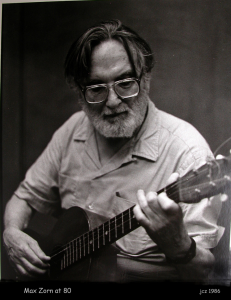On 11 March 1993, journalist Eric Zorn wrote a column about his grandfather, who had died in his lap two days earlier. The title of the column, “Mathematical wizard, hero for his family”, was as intentional as the first sentence: “I do not pretend to understand Zorn’s lemma”. Eric Zorn says that it is not unusual to be asked when he is introduced to a mathematican, “Are you related to the Zorn?” And he is. Eric Zorn is Max Zorn’s only grandson. And, as he tells us in his column, he was always very proud of this, although he also acknowledges that: “What I was always most proud of was not that he had written the Lemma, but that he had fought before the Second World War against the then emerging Nazi party in his native Germany”. In fact, the somewhat scratchy tone of Max Zorn’s voice was due to blows to his throat in a street fight against pro-Hitler thugs. Max Zorn, along with his wife and son, emigrated to the United States shortly after Hitler took power in Germany in 1933.

Once in the United States, Max Zorn formulated in 1935 the Lemma by which he has passed on to mathematical posterity. In its original version, Zorn’s Lemma states the following. By a chain of sets we mean a family in which one of every two sets must be a subset of the other; we now say that a collection of sets is closed if the union of each chain in that collection also belongs to the collection. Zorn’s lemma ensures that in every closed collection there is a maximal element, that is, a set that is not contained in any other set in the collection. The Zorn Lemma is equivalent (assuming the axioms of Zermelo-Fraenkel) to other basic principles of set theory, such as the axiom of choice or the well’ordering theorem. It is also equivalent to other fundamental results in various areas of mathematics (the existence of base in vector spaces of infinite dimension, or the Tychonoff theorem that establishes the compactness of the topology produced by compact topological spaces).
In his book I want to be a mathematician, Paul Halmos tells how he met Zorn during a lecture at Indiana University in the late 1960s: “I went there, gave a lecture, and shook hands. I met Max Zorn, who would later become a valuable and good friend. He came to the reception afterwards with a list of questions, questions he had been collecting to ask me! Max has an outstanding and inveterate ability to ask questions; in private or in a public discussion he always puts his finger on the exact spot where the deepest ideas are hidden”.
According to his grandson, the Lemma gave Max Zorn international recognition, but ended up haunting him, as early glory so often does.
With quite a different intention to that of his grandson, Halmos began the sort of obituary he dedicated to Zorn at the end of 1993 as follows: “Max Zorn was born 29 years before Zorn’s Lemma, and Zorn’s Lemma, his technique and his attitude, will live on for centuries. Although for Max, his Lemma was an observation, since he titled the article where he proposed it as “An observation on a method in transfinite algebra”; it was John Tukey who baptised the result”.
In that sentence of Halmos it is not difficult to find the echoes of Hardy’s famous speech about the immortality of mathematics: “Archimedes will be remembered even if Aeschylus has been forgotten, because languages perish while mathematical ideas never die. Perhaps “immortality” is an absurd term, but it is quite likely that a mathematician will understand its exact meaning”.
Eric Zorn ended the column dedicated to his grandfather by pointing in another direction: “With great difficulty and breathlessness he said: “My family loves me”. It was the last sentence he said, and perhaps it was not something as profound or famous as Zorn’s Lemma, but equally lasting and, I think, deeper. It will also be his legacy”.
References:
P. Halmos, Postcards from Max, Amer. Math. Monthly 100 (10) (1993), 942-944.
P. Halmos, I Want to Be a Mathematician. Springer-Verlag.
G.H. Hardy, A mathematician’s apology, Cambridge University Press, 1967 (traducciones al castellano: Autojustificación de un matemático, Ariel, Barcelona, Apología de un matemático, Nivola, Madrid, 1999).

Leave a Reply